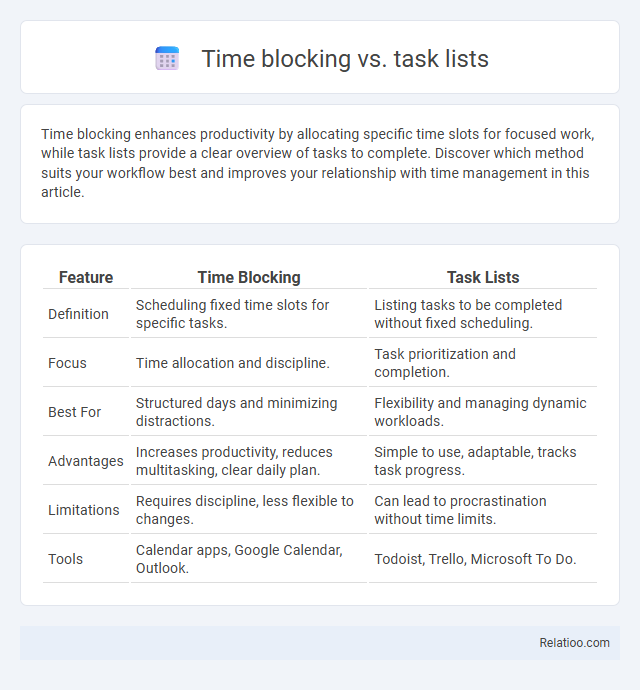Time blocking enhances productivity by allocating specific time slots for focused work, while task lists provide a clear overview of tasks to complete. Discover which method suits your workflow best and improves your relationship with time management in this article.
Table of Comparison
| Feature | Time Blocking | Task Lists |
|---|---|---|
| Definition | Scheduling fixed time slots for specific tasks. | Listing tasks to be completed without fixed scheduling. |
| Focus | Time allocation and discipline. | Task prioritization and completion. |
| Best For | Structured days and minimizing distractions. | Flexibility and managing dynamic workloads. |
| Advantages | Increases productivity, reduces multitasking, clear daily plan. | Simple to use, adaptable, tracks task progress. |
| Limitations | Requires discipline, less flexible to changes. | Can lead to procrastination without time limits. |
| Tools | Calendar apps, Google Calendar, Outlook. | Todoist, Trello, Microsoft To Do. |
Introduction to Time Blocking and Task Lists
Time blocking divides your day into dedicated intervals for specific activities, enhancing focus by minimizing multitasking. Task lists organize responsibilities by priority, offering a clear overview but lacking built-in time constraints. Understanding these methods empowers you to improve productivity by aligning your schedule with intentional work patterns.
Core Principles of Time Blocking
Time blocking involves dividing your day into dedicated intervals for specific tasks, enhancing focus and productivity by reducing multitasking and distractions. Core principles of time blocking emphasize setting clear priorities, allocating realistic time frames, and maintaining flexibility to adapt to unexpected changes. By mastering these techniques, you can optimize your workflow, ensuring your most important tasks receive your full attention and energy.
Key Features of Task Lists
Task lists organize your activities by breaking down projects into individual, manageable tasks, allowing clear prioritization and progress tracking. This method increases productivity by providing a detailed overview of what needs to be accomplished, ensuring no critical action is overlooked. Your efficiency improves as task lists help you maintain focus on specific objectives without the distraction of multitasking.
Benefits of Using Time Blocking
Time blocking enhances your productivity by allocating specific time slots for tasks, reducing distractions and promoting deep focus. Unlike task lists, which can become overwhelming or endless, time blocking creates a structured schedule that helps you prioritize effectively and manage your energy levels throughout the day. Embracing time blocking leads to better time management, increased accountability, and a clearer sense of progress in your work.
Advantages of Task Lists
Task lists offer clear advantages by providing structured organization and prioritization of daily activities, enhancing productivity through focused action steps. They allow for easy tracking of completed tasks, which builds motivation and ensures accountability in goal achievement. Additionally, task lists improve time management by breaking projects into manageable segments, reducing overwhelm and increasing efficiency.
Common Challenges with Time Blocking
Time blocking often faces challenges such as inaccurate estimation of task durations, leading to schedule overruns and stress. Users may struggle with interruptions and unexpected events that disrupt rigid time blocks, reducing overall productivity. Balancing flexibility with strict time allocation requires intentionality to adapt plans without losing focus on priority tasks.
Potential Drawbacks of Task Lists
Task lists often lead to overwhelming to-do piles, which can decrease Your focus and productivity by encouraging multitasking rather than deep work. Unlike time blocking, task lists lack dedicated time allocations, causing procrastination and difficulty prioritizing high-impact activities. Intentionality requires mindful planning that task lists alone may not support, increasing the risk of neglecting long-term goals due to a narrow focus on immediate tasks.
When to Choose Time Blocking Over Task Lists
Time blocking suits You best when managing complex projects or deep work requiring sustained focus, as it allocates specific time periods for each activity, reducing distractions and enhancing productivity. Task lists excel for capturing and organizing discrete actionable items but may lead to time mismanagement if used alone for extensive tasks. Intentionality elevates both methods by aligning tasks with core goals, ensuring Your schedule reflects priorities rather than just completion.
Hybrid Approaches: Combining Time Blocking and Task Lists
Hybrid approaches that combine time blocking and task lists enhance productivity by integrating structured scheduling with flexible task management. Time blocking assigns specific time periods to tasks, ensuring dedicated focus, while task lists provide a comprehensive overview of priorities and deadlines. This synergy supports intentionality by enabling users to adapt their plans dynamically while maintaining disciplined work intervals, optimizing both focus and responsiveness.
Conclusion: Selecting the Right Productivity Method
Choosing the right productivity method depends on Your unique workflow and goals, with time blocking offering structured scheduling, task lists providing flexible organization, and intentionality driving purposeful action. Evaluating the balance between control, adaptability, and motivation helps optimize productivity outcomes. Consistent reflection on these approaches ensures sustained focus and efficiency tailored to your personal and professional demands.

Infographic: Time blocking vs Task lists
 relatioo.com
relatioo.com